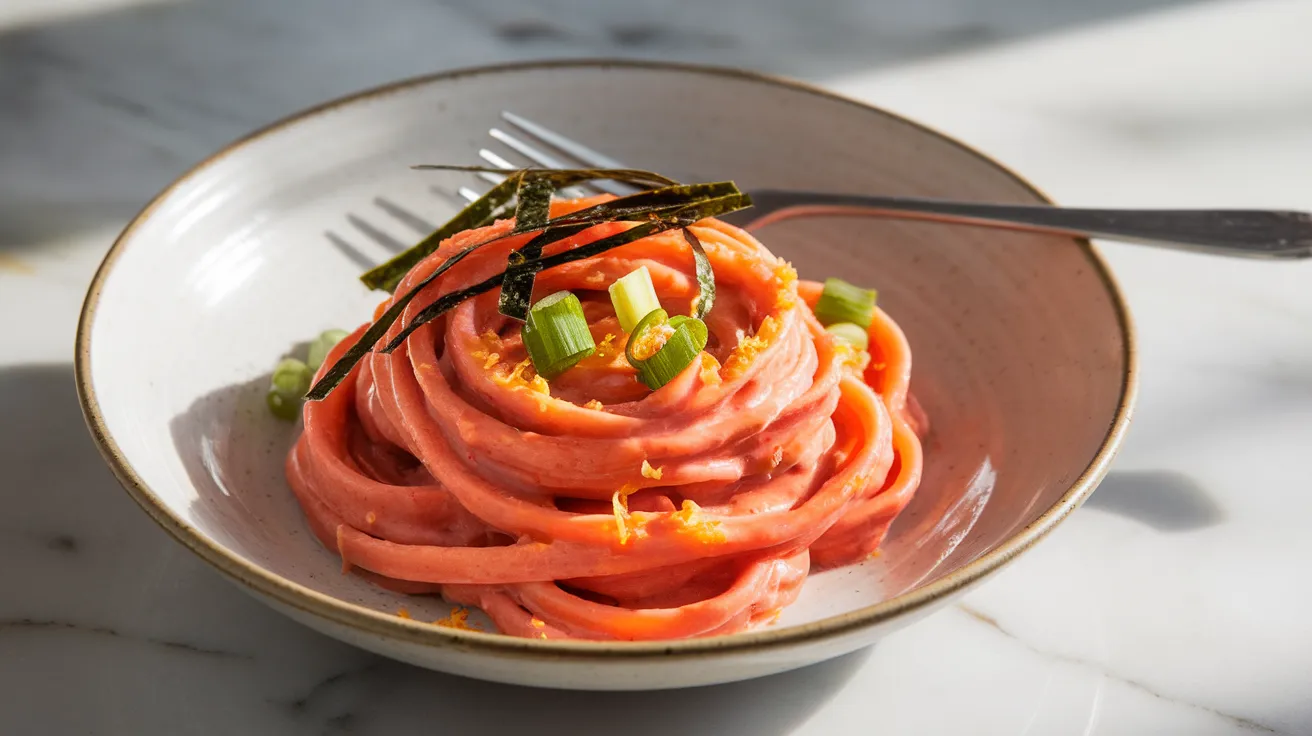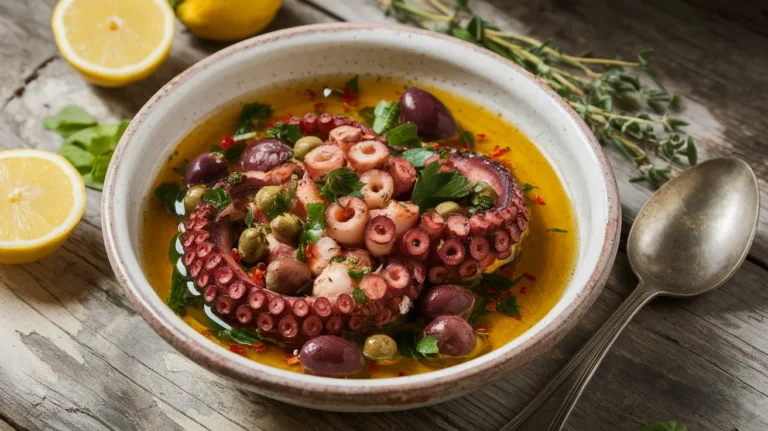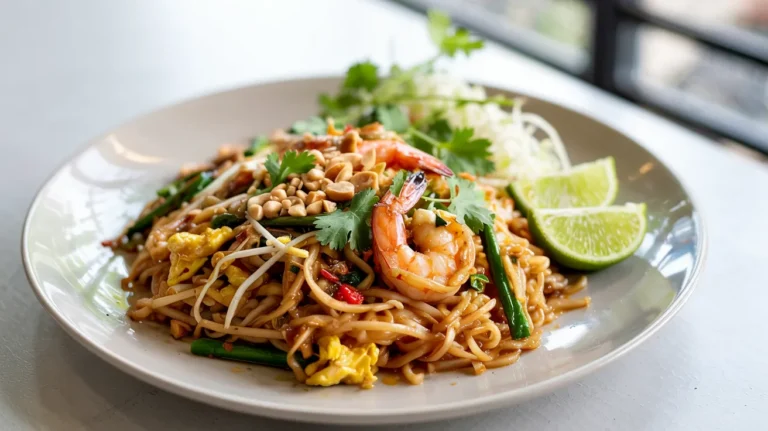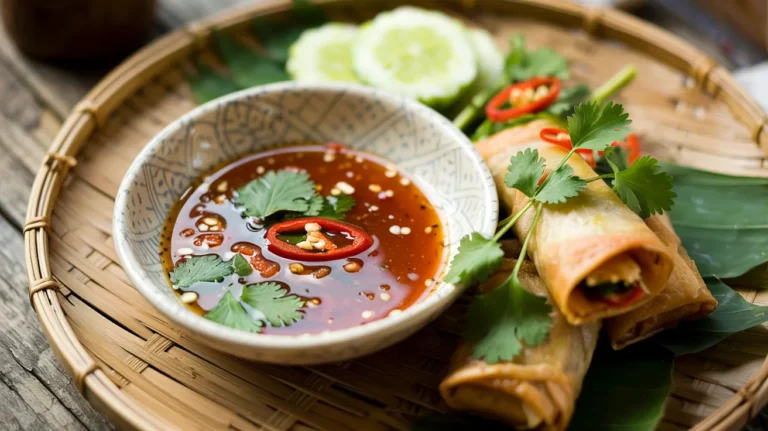Experience the luxurious, briny essence of Japanese cuisine with this authentic tarako sauce recipe. This vibrant coral-colored sauce combines salted cod roe with creamy butter and aromatic seasonings to create an umami-rich condiment that transforms simple pasta into a gourmet experience. Perfect for adventurous home cooks wanting to explore traditional Japanese flavors, this tarako sauce delivers restaurant-quality results in your own kitchen.
SERVES: 4 | PREP: 15 MIN | COOK: 8 MIN | TOTAL: 23 MIN
Ingredients
Main Components
| Ingredient | Amount | Notes |
|---|---|---|
| Tarako (salted cod roe sacs) | 4 sacs (120g) | Fresh or frozen |
| Unsalted butter | 4 tablespoons | Room temperature |
| Heavy cream | 1/3 cup | Cold |
| Fresh pasta | 12 oz | Linguine or spaghetti |
Flavor Enhancers
| Ingredient | Amount | Notes |
|---|---|---|
| Fresh lemon juice | 1 tablespoon | Freshly squeezed |
| Sake or dry white wine | 2 tablespoons | Optional |
| Garlic | 1 small clove | Minced fine |
| White pepper | 1/4 teaspoon | Freshly ground |
Garnish
| Ingredient | Amount | Notes |
|---|---|---|
| Nori (seaweed) | 1 sheet | Cut into thin strips |
| Scallions | 2 stalks | Green parts only |
| Lemon zest | 1 teaspoon | Optional |
Step-by-Step Instructions
Phase 1: Preparing the Tarako (5 minutes)
1. Remove tarako sacs from refrigerator 10 minutes before cooking to bring closer to room temperature. This prevents the delicate roe from seizing when heated.
2. Using a sharp paring knife, make a shallow lengthwise cut along each tarako sac. Be gentle – you want to open the membrane without crushing the tiny roe inside.
3. Using the back of a spoon, gently scrape out all the roe from inside the sacs into a medium mixing bowl. Discard the thin membranes completely.
4. Break up any large clumps of roe with a fork, creating a relatively smooth texture. The roe should look like coarse, coral-colored caviar.
Phase 2: Creating the Base Sauce (3 minutes)
5. Add room-temperature butter to the bowl with the tarako roe. The butter should be soft enough to mash easily but not melted.
6. Using a wooden spoon, cream the butter and roe together until well combined. This creates the rich, creamy foundation of your tarako sauce.
7. Slowly drizzle in the cold heavy cream while stirring constantly. The mixture should become smooth and pale orange in color.
8. Add minced garlic, lemon juice, and white pepper. Stir until completely incorporated. Taste and adjust seasoning – the sauce should be creamy with a pleasant briny flavor.
Phase 3: Cooking the Pasta (8-10 minutes)
9. Bring a large pot of heavily salted water to a rolling boil. The water should taste like seawater for properly seasoned pasta.
10. Add fresh pasta and cook according to package directions until al dente. Fresh pasta typically cooks in 2-4 minutes, so watch carefully.
11. Reserve 1 cup of starchy pasta cooking water before draining. This liquid gold will help bind the sauce perfectly to the noodles.
12. Drain pasta quickly but don’t rinse – you want to retain some surface starch for better sauce adhesion.
Phase 4: Final Assembly (2-3 minutes)
13. Return the hot, drained pasta immediately to the cooking pot over the lowest heat setting. The residual heat will gently warm the tarako sauce without cooking it.
14. Add the prepared tarako sauce to the pasta and toss gently using tongs or pasta forks. Work quickly to prevent the delicate roe from overcooking.
15. Gradually add reserved pasta water, 1-2 tablespoons at a time, until the sauce coats every strand of pasta beautifully. The consistency should be creamy but not heavy.
16. Remove from heat immediately and divide among four warmed serving bowls. Speed is crucial here to maintain the perfect texture.
Phase 5: Garnishing and Serving (1 minute)
17. Top each portion with thin strips of nori and finely chopped scallion greens. These add color contrast and complementary ocean flavors.
18. Add a light sprinkle of lemon zest if desired, and serve immediately while the pasta is still steaming hot.
Chef’s Notes
Tarako Quality Matters: Fresh or high-quality frozen tarako produces the best flavor. Look for plump, firm sacs with vibrant color at Japanese markets or specialty seafood stores.
Temperature Control: Never let your tarako sauce boil or even simmer. High heat will cause the delicate roe to burst and become grainy, ruining the smooth texture.
Pasta Water Magic: The starchy cooking water is essential for creating silky sauce consistency. Always reserve more than you think you’ll need.
Serving Speed: This tarako sauce dish is best enjoyed immediately. The creamy texture and delicate flavors diminish quickly as it cools.
Nutrition Information (Per Serving)
- Calories: 385
- Protein: 18g
- Carbohydrates: 42g
- Fat: 16g
- Sodium: 890mg
- Fiber: 2g
Creative Variations
Spicy Tarako: Add a pinch of shichimi togarashi (Japanese seven spice) or finely minced fresh chili for heat that complements the briny roe.
Mentaiko Style: Transform this recipe into mentaiko sauce by adding Korean gochugaru chili flakes and extra garlic for a spicier, more complex flavor profile that’s equally beloved in Japanese cuisine.
Creamy Mushroom Tarako: Sauté sliced shiitake mushrooms in butter before adding the tarako sauce for earthy depth and textural contrast.
Tarako Carbonara Fusion: Incorporate beaten egg yolks during the final tossing stage to create a rich, custard-like sauce that bridges Italian and Japanese cooking traditions, similar to how bhuna sauce combines different cultural influences.
Storage & Reheating
Refrigeration: Store leftover tarako sauce separately from pasta in an airtight container for up to 2 days. The delicate roe texture deteriorates quickly.
Reheating Method: Gently rewarm sauce in a double boiler over barely simmering water, stirring constantly. Never use direct heat or microwave.
Fresh Pasta Storage: Cook fresh pasta just before serving. Leftover cooked pasta can be stored for 1 day and quickly refreshed in boiling water.
Make-Ahead Tips: Prepare the tarako sauce base up to 4 hours ahead and keep refrigerated. Bring to room temperature before combining with hot pasta.
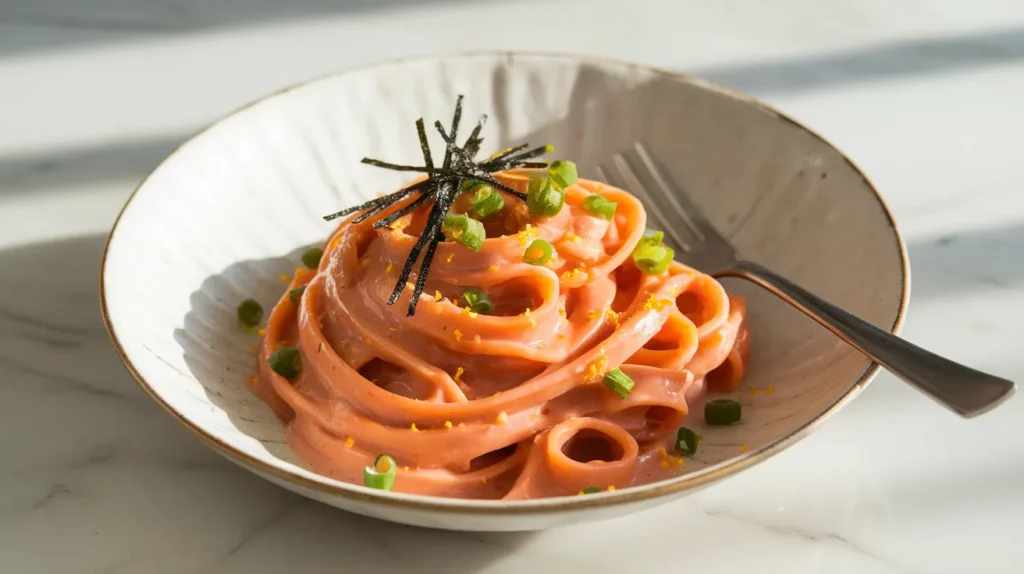
Troubleshooting Guide
Problem: Grainy or Curdled Sauce Solution: The roe was exposed to too much heat. Start over with fresh tarako and keep temperatures very low throughout cooking.
Problem: Sauce Too Thin Solution: Add more room-temperature butter, one tablespoon at a time, or reduce the amount of pasta water used during tossing.
Problem: Overly Salty Taste Solution: Tarako varies in saltiness. Balance with additional cream and a squeeze of fresh lemon juice to brighten the overall flavor.
Problem: Sauce Won’t Adhere to Pasta Solution: You need more starchy pasta water. Add gradually while tossing over gentle heat until proper consistency develops.
Problem: Bland Overall Flavor Solution: Increase the garlic slightly, add more lemon juice, or finish with a small pinch of quality sea salt to enhance the natural brininess.
Equipment Essentials
- Large pasta pot with lid
- Fine-mesh colander
- Medium mixing bowl
- Wooden spoon or silicone spatula
- Sharp paring knife
- Pasta tongs or serving forks
- Measuring cups and spoons
- Four warmed serving bowls
Shopping List
Seafood Counter
- Tarako (salted cod roe sacs)
Dairy Section
- Unsalted butter
- Heavy cream
Produce Section
- Fresh garlic
- Lemons
- Scallions
Pantry/Dry Goods
- Fresh pasta (linguine or spaghetti)
- White pepper
- Sake or dry white wine
Asian Grocery Section
- Nori sheets
- Shichimi togarashi (optional)
Success Secrets
1. Always taste your tarako before cooking – salt levels vary significantly between brands and batches, affecting your final seasoning needs.
2. Work with room-temperature ingredients whenever possible. Cold butter and roe won’t emulsify properly with the warm pasta and cooking water.
3. Use the largest bowl or pot possible for final tossing. This gives you maximum surface area to properly coat every strand of pasta.
4. Master the pasta water technique – add small amounts gradually while tossing continuously to achieve restaurant-quality sauce consistency.
5. Serve in warmed bowls to maintain optimal temperature and prevent the delicate tarako sauce from cooling too quickly during the meal.
